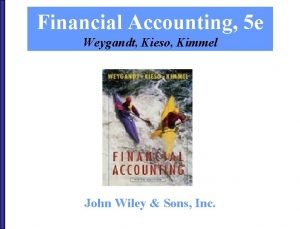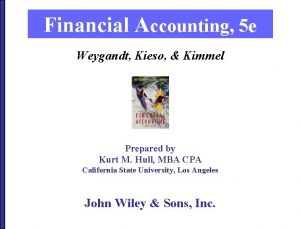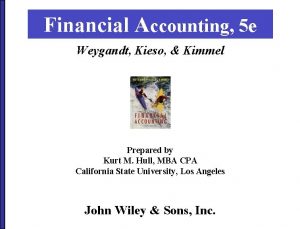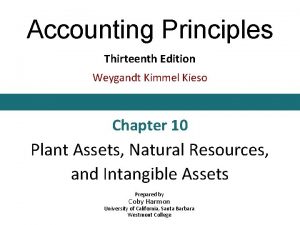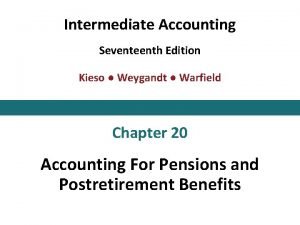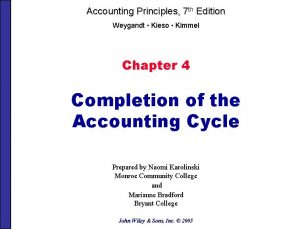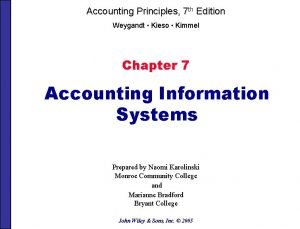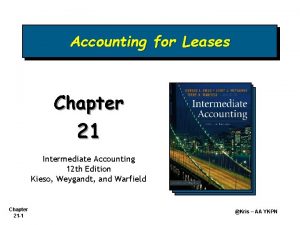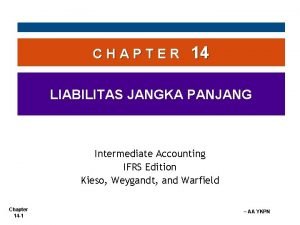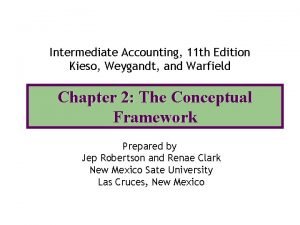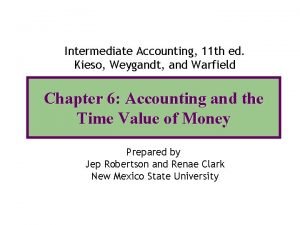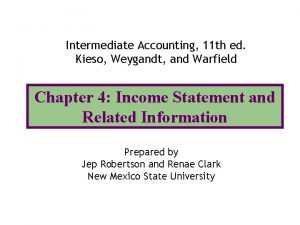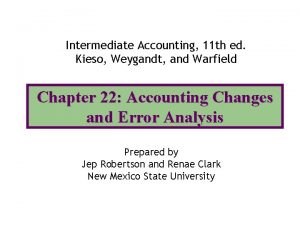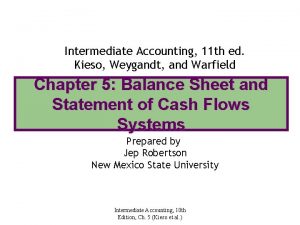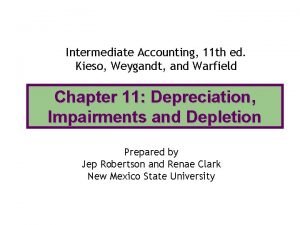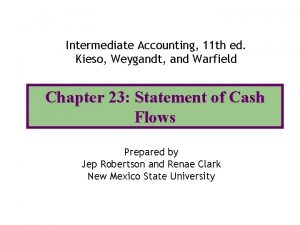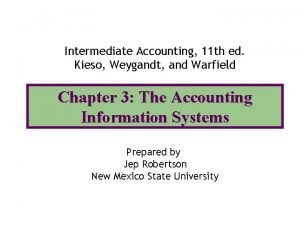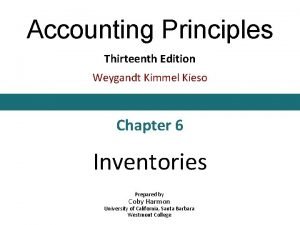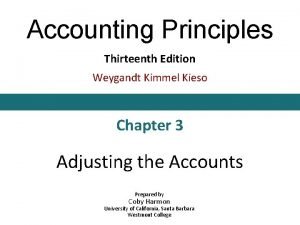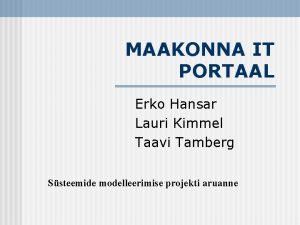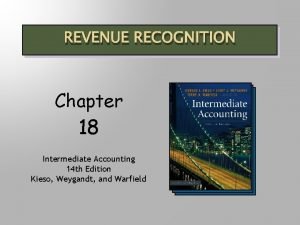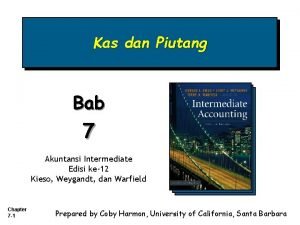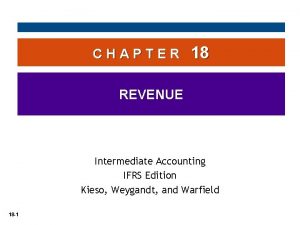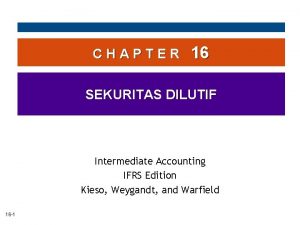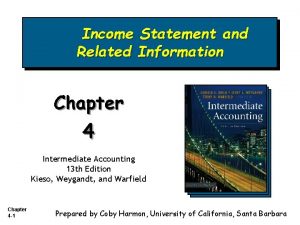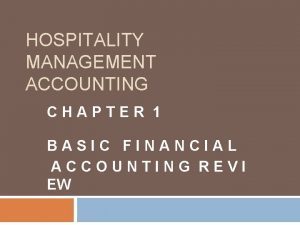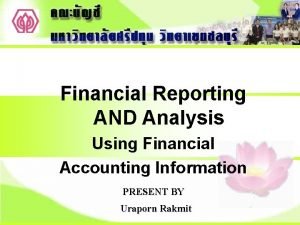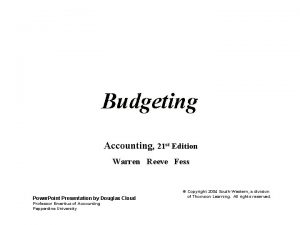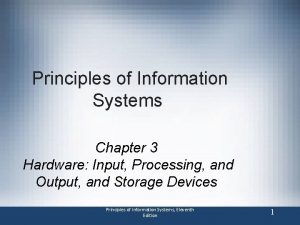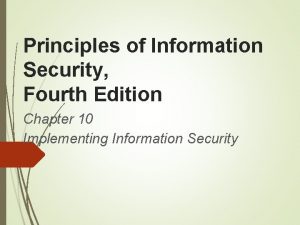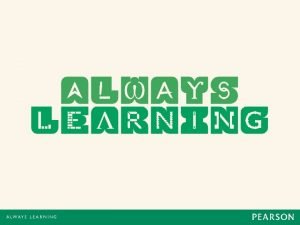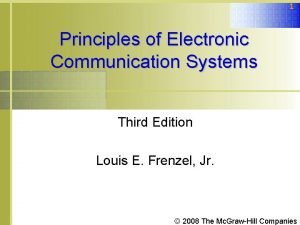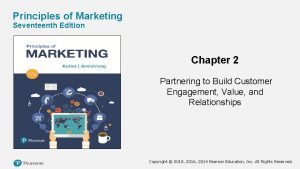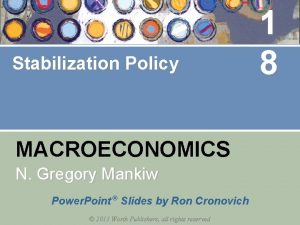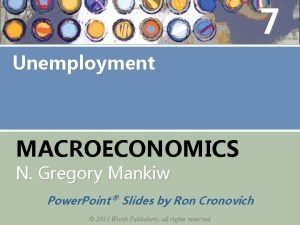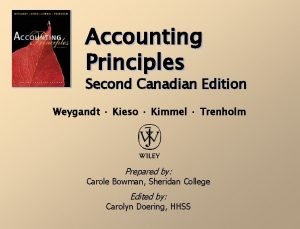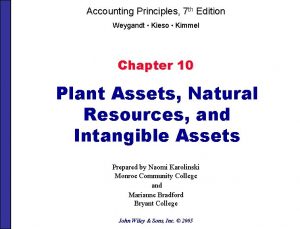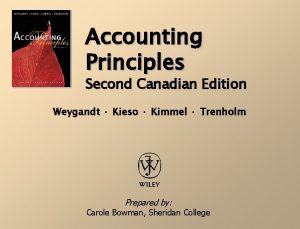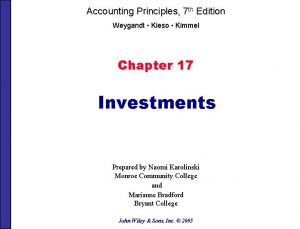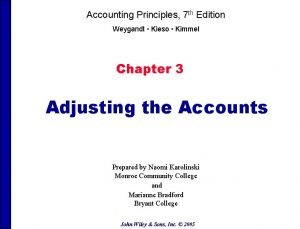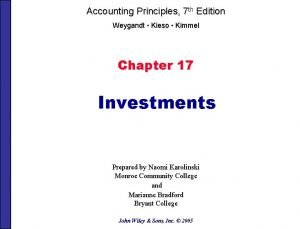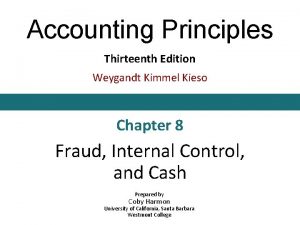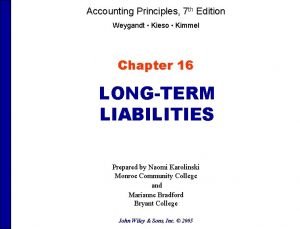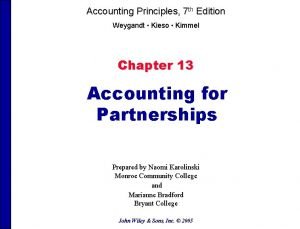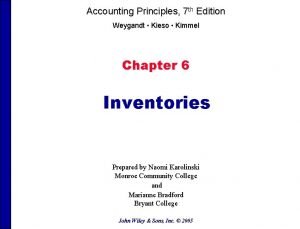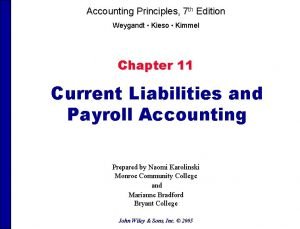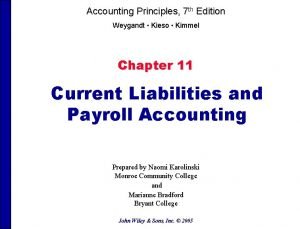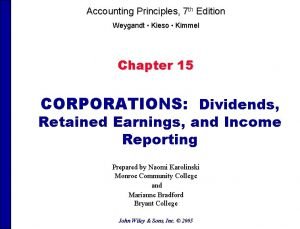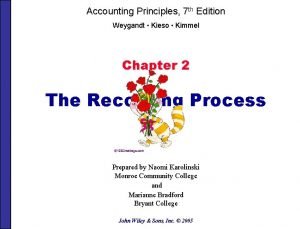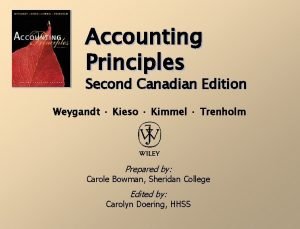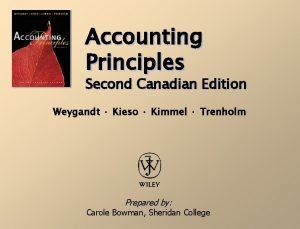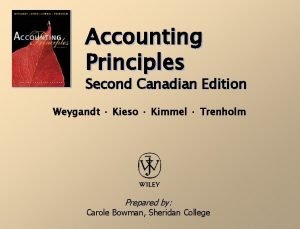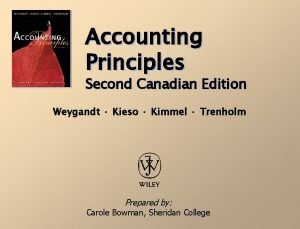Accounting Principles 7 th Edition Weygandt Kieso Kimmel































































- Slides: 63

Accounting Principles, 7 th Edition Weygandt • Kieso • Kimmel Chapter 5 Accounting for Merchandising Operations Prepared by Naomi Karolinski Monroe Community College and Marianne Bradford Bryant College John Wiley & Sons, Inc. © 2005

CHAPTER 5 ACCOUNTING FOR MERCHANDISING OPERATIONS After studying this chapter, you should be able to: 1 identify the differences between a service enterprise and a merchandising company 2 explain the entries for purchases under a perpetual inventory system 3 explain the entries for sales revenues under a perpetual inventory system 4 explain the steps in the accounting cycle for a merchandising company

CHAPTER 5 ACCOUNTING FOR MERCHANDISING OPERATIONS After studying this chapter, you should be able to: 5 distinguish between a multiple-step and a single-step income statement 6 explain the computation and importance of gross profit 7 determine the cost of goods sold under a periodic system

MERCHANDISING COMPANY A merchandising company buys and sells goods to earn a profit. 1) Wholesalers sell to retailers 2) Retailers sell to consumers Primary source of revenue is Sales

MEASURING NET INCOME • Expenses for a merchandiser are divided into two categories: 1 Cost of goods sold – The total cost of merchandise sold during the period 2 Operating expenses – Expenses incurred in the process of earning sales revenue (Examples: sales salaries and insurance expense) • Gross profit is equal to Sales Revenue less Cost of Goods Sold

INCOME MEASUREMENT PROCESS FOR A MERCHANDISING COMPANY

OPERATING CYCLES FOR A SERVICE COMPANY AND A MERCHANDISING COMPANY

INVENTORY SYSTEMS Merchandising entities may use either: 1) Perpetual Inventory Detailed records of the cost of each item are maintained, and the cost of each item sold is determined from records when the sale occurs. 2) Periodic Inventory the Cost of goods sold is determined only at end of an accounting period.

PERPETUAL VS. PERIODIC

COST OF GOODS SOLD To determine the cost of goods sold under a periodic inventory system: 1) Determine the cost of goods on hand at the beginning of the accounting period, 2) Add to it the cost of goods purchased, and 3) Subtract the cost of goods on hand at the end of the accounting period.

PURCHASES OF MERCHANDISE STUDY OBJECTIVE 2 • Merchandise is purchased for resale to customers, the account – Merchandise Inventory is debited for the cost of goods. • Like sales, purchases may be made for cash or on account (credit). • The purchase is normally recorded by the purchaser when the goods are received from the seller. • Each credit purchase should be supported by a purchase invoice.

PURCHASES OF MERCHANDISE SALES INVOICE

PURCHASES OF MERCHANDISE 3, 800 For purchases on account, Merchandise Inventory is debited and Accounts Payable is credited.

PURCHASE RETURNS AND ALLOWANCES • A purchaser may be dissatisfied with merchandise received because the goods: 1) are damaged or defective, 2) are of inferior quality, or 3) are not in accord with the purchaser’s specifications. • The purchaser initiates the request for a reduction of the balance due through the issuance of a debit memorandum (purchaser’s debit decreases A/P!). • The debit memorandum is a document issued by a buyer to inform a seller that the seller’s account has been debited because of unsatisfactory merchandise.

PURCHASE RETURNS AND ALLOWANCES 300 For purchases returns and allowances, Accounts Payable is debited and Merchandise Inventory is credited.

FREE ON BOARD A sales agreement should indicate whether the seller or the buyer is to pay the cost of transporting the goods to the buyer’s place of business. • FOB Shipping Point 1) Goods placed free on board the carrier by seller 2) Buyer pays freight costs • FOB Destination 1) Goods placed free on board at buyer’s business 2) Seller pays freight costs

ACCOUNTING FOR FREIGHT COSTS • Merchandise Inventory is debited if buyer pays freight. • Freight-out (or Delivery Expense) is debited if seller pays freight.

ACCOUNTING FOR FREIGHT COSTS 150 When the purchaser directly incurs the freight costs, the account Merchandise Inventory is debited and Cash is credited.

ACCOUNTING FOR FREIGHT COSTS 150 Freight costs incurred by the seller on outgoing merchandise are debited to Freight-out (or Delivery Expense) and Cash is credited.

PURCHASE DISCOUNTS • Credit terms may permit the buyer to claim a cash discount for the prompt payment of a balance due. • The buyer calls this discount a purchase discount. • Like a sales discount, a purchase discount is based on the invoice cost less returns and allowances, if any.

PURCHASE DISCOUNTS 3, 500 3, 430 70 If payment is made within the discount period, Accounts Payable is debited, Cash is credited, and Merchandise inventory is credited for the discount taken.

PURCHASE DISCOUNTS 3, 500 If payment is made after the discount period, Accounts Payable is debited and Cash is credited for the full amount.

SAVINGS OBTAINED BY TAKING PURCHASE DISCOUNT A buyer should usually take all available discounts. If Beyer Video takes the discount, it pays $70 less in cash. If it forgoes the discount and invests the $3, 500 for 20 days at 10% interest, it will earn only $19. 44 in interest. The savings obtained by taking the discount is calculated as follows:

SALES TRANSACTIONS STUDY OBJECTIVE 3 • Revenues – (Revenue recognition principle) – Earned when the goods are transferred from seller to buyer • All sales should be supported by a document such as a cash register tape or sales invoice.

RECORDING CASH SALES 2, 200 1, 400 l For cash sales, Cash is debited and Sales is credited. l For the cost of goods sold for cash, Cost of Goods Sold is debited and Merchandise Inventory is credited.

RECORDING CREDIT SALES 3, 800 2, 400 l For credit sales, Accounts Receivable is debited and Sales is credited. l For the cost of goods sold on account, Cost of Goods Sold is debited and Merchandise Inventory is credited.

SALES RETURNS AND ALLOWANCES • Sales Returns – Customers dissatisfied with merchandise and are allowed to return the goods to the seller for credit or a refund. • Sales Allowances – Result when customers are dissatisfied and the seller allows a deduction from the selling price.

SALES RETURNS AND ALLOWANCES • Credit memorandum – the seller prepares a form to inform the customer that a credit has been made to the customer’s account receivable • Sales Returns and Allowances – Contra revenue account to the Sales account • The normal balance of Sales Returns and Allowances is a debit

RECORDING SALES RETURNS AND ALLOWANCES 300 140 The seller’s entry to record a credit memorandum involves a debit to the Sales Returns and Allowances account and a credit to Accounts Receivable. The entry to record the cost of the returned goods involves a debit to Merchandise Inventory and a credit to Cost Goods Sold.

SALES DISCOUNTS • Sales discount – Offer of a cash discount to a customer for the prompt payment of a balance due – Is a contra revenue account with a normal debit balance • Example: Credit sale has the terms 3/10, n/30, a 3% discount is allowed if payment is made within 10 days. After 10 days there is no discount, and the balance is due in 30 days.

CREDIT TERMS Credit terms specify the amount and time period for the cash discount – Indicates the length of time in which the purchaser is expected to pay the full invoice price 2/10, n/30 A 2% discount may be taken if payment is made within 10 days of the invoice date. 1/10 EOM A 1% discount is available if payment is made by the 10 th of the next month.

RECORDING SALES DISCOUNTS 3, 430 70 3, 500 When cash discounts are taken by customers, the seller debits Sales Discounts.

CLOSING ENTRIES STUDY OBJECTIVE 4 l Adjusting entries are journalized from the adjustment columns of the work sheet. l All accounts that affect the determination of net income are closed to Income Summary. l Data for the preparation of closing entries may be obtained from the income statement columns of the work sheet. 480, 000

CLOSING ENTRIES Cost of Goods Sold is a new account that must be closed to Income Summary.

CLOSING ENTRIES l After the closing entries are posted, all temporary accounts have zero balances l It addition, R. A. Lamb, Capital has a credit balance of $98, 000 ($83, 000 + $30, 000 - $15, 000).

Under a perpetual inventory system, acquisition of merchandise for resale is debited to the a. b. c. d. Chapter 5 purchases account supplies account merchandise inventory account cost of goods sold account

Under a perpetual inventory system, acquisition of merchandise for resale is debited to the a. b. c. d. Chapter 5 purchases account supplies account merchandise inventory account cost of goods sold account

MULTIPLE-STEP INCOME STATEMENT STUDY OBJECTIVE 5 • Includes sales revenue, cost of goods sold, and gross profit sections • Additional nonoperating sections may be added for: 1) revenues and expenses resulting from secondary or auxiliary operations 2) gains and losses unrelated to operations

MULTIPLE-STEP INCOME STATEMENT Operating expenses may be subdivided into: a) Selling expenses b) Administrative expenses Nonoperating sections are reported after income from operations and are classified as: a) Other revenues and gains b) Other expenses and losses

SINGLE-STEP INCOME STATEMENT All data are classified under two categories: 1 Revenues 2 Expenses Only one step is required in determining net income or net loss.

COMPUTATION OF GROSS PROFIT STUDY OBJECTIVE 6 Gross profit is determined as follows: Net sales Cost of goods sold Gross profit $ 460, 000 316, 000 $ 144, 000

OPERATING EXPENSES IN COMPUTING NET INCOME Net income is determined as follows: Gross profit Operating expenses Net income $ 144, 000 114, 000 $ 30, 000

Gross profit for a merchandiser is net sales minus a. b. c. d. Chapter 5 operating expenses cost of goods sold sales discounts cost of goods available for sale

Gross profit for a merchandiser is net sales minus a. b. c. d. Chapter 5 operating expenses cost of goods sold sales discounts cost of goods available for sale

PERIODIC INVENTORY SYSTEMS Appendix 5 A • Revenues from the sale of merchandise are recorded when sales are made in the same way as in a perpetual system • No attempt is made on the date of sale to record the cost of merchandise sold • Physical inventories are taken at end of period to determine: – The cost of merchandise on hand – The cost of the goods sold during the period

Determining Cost of Goods Sold Periodic STUDY OBJECTIVE 7

RECORDING MERCHANDISE TRANSACTIONS UNDER A PERIODIC INVENTORY SYSTEM • Purchases – Merchandise purchased for resale to customers – May be made for cash or on account (credit) – Normally recorded by the purchaser when the goods are received from the seller – Credit purchase should be supported by a purchase invoice

RECORDING PURCHASES OF MERCHANDISE May 4 Purchases Accounts Payable 3, 800 To illustrate the recording of merchandise transactions under a periodic system, we will use the purchase/sale transactions between Seller and Buyer. For purchases on account, Purchases is debited and Accounts Payable is credited for merchandise ordered from Seller. 3, 800

PURCHASE RETURNS AND ALLOWANCES • A sales return and allowance on the seller’s books is recorded as a purchase return and allowance on the books of the purchaser. • Purchase Returns and Allowances – contra account to Purchases – Normal credit balance • Debit memorandum – Purchaser initiates the request for a reduction of the balance due through the issuance of a debit memorandum – A document issued by a buyer to inform a seller that the seller’s account has been debited because of unsatisfactory merchandise

RECORDING PURCHASE RETURNS AND ALLOWANCES May 8 Accounts Payable Purchase Returns and Allowances 300 For purchases returns and allowances, Accounts Payable is debited and Purchase Returns and Allowances is credited. Because $300 of merchandise received from Seller is inoperable, Buyer returns the goods and issues a debit memo. 300

ACCOUNTING FOR FREIGHT COSTS • Freight-in is debited if buyer pays freight • Freight-out (or Delivery Expense) is debited if seller pays freight

ACCOUNTING FOR FREIGHT COSTS May 9 Freight-in Cash 150 When the purchaser directly incurs the freight costs, the account Freight-in (or Transportation-in) is debited and Cash is credited. In this example, Buyer pays Acme Freight Company $150 for freight charges on its purchase from Seller. 150

PURCHASE DISCOUNTS • Credit terms may permit the buyer to claim a cash discount for the prompt payment of a balance due. • The buyer calls this discount a purchase discount. • Like a sales discount, a purchase discount is based on the invoice cost less returns and allowances, if any.

PURCHASE DISCOUNTS May 14 Accounts Payable Purchase Discounts 3, 500 70 Cash 3, 430 If payment is made within the discount period, Accounts Payable is debited, Purchase Discounts is credited for the discount taken, and Cash is credited. On May 14 Buyer pays the balance due on account to Seller taking the 2% cash discount allowed by Seller for payment within 10 days.

RECORDING SALES OF MERCHANDISE May 4 Accounts Receivable Sales 3, 800 For credit sales, Accounts Receivable is debited and Sales is credited. In this illustration, the sale of $3, 800 of merchandise to Buyer on May 4 is recorded by the Seller. 3, 800

RECORDING SALES RETURNS AND ALLOWANCES May 8 Sales Returns and Allowances Accounts Receivable 300 The seller’s entry to record a credit memorandum involves a debit to the Sales Returns and Allowances account and a credit to Accounts Receivable. Based on the debit memo received from Buyer on May 8 for returned goods, Seller records the $300 sales returns above.

RECORDING SALES DISCOUNTS May 15 Cash Sales Discounts Accounts Receivable 3, 430 3, 500 When cash discounts are taken by customers, the seller debits Sales Discounts. On May 15, Seller receives payment of $3, 430 on account from Buyer. Seller honors the 2% discount and records the payment of Buyer’s accounts receivable. 70

WORK SHEET FOR A MERCHANDISING COMPANY

USING A WORK SHEET Appendix 5 B Trial Balance Columns 1 Data from the trial balance are obtained from the ledger balances of Sellers Electronix at December 31 2 The amount shown for Merchandise Inventory, $40, 500, is the year-end inventory amount which results from the application of a perpetual inventory system

USING A WORK SHEET Adjustments Columns 1 A merchandising company usually has the same types of adjustments as a service company 2 Work sheet adjustments b, c, and d are for insurance, depreciation, and salaries Adjusted Trial Balance - The adjusted trial balance shows the balance of all accounts after adjustment at the end of the accounting period

USING A WORK SHEET Income Statement Columns 1 The accounts and balances that affect the income statement are transferred from the adjusted trial balance columns to the income statement columns for Sellers Electronix at December 31 2 All of the amounts in the income statement credit column should be totaled and compared to the total of the amounts in

USING A WORK SHEET Balance Sheet Columns 1 The major difference between the balance sheets of a service company and a merchandising company is inventory 2 For Sellers Electronix, the ending Merchandise Inventory amount of $40, 000 is shown in the balance sheet debit column 3 The information to prepare the owner’s equity

COPYRIGHT Copyright © 2005 John Wiley & Sons, Inc. All rights reserved. Reproduction or translation of this work beyond that permitted in Section 117 of the 1976 United States Copyright Act without the express written consent of the copyright owner is unlawful. Request for further information should be addressed to the Permissions Department, John Wiley & Sons, Inc. The purchaser may make back-up copies for his/her own use only and not for distribution or resale. The Publisher assumes no responsibility for errors, omissions, or damages, caused by the use of these programs or from the use of the information contained herein.
 Kimmel accounting tools 5e
Kimmel accounting tools 5e Kimmel weygandt kieso accounting 5th edition
Kimmel weygandt kieso accounting 5th edition Kimmel weygandt kieso accounting 5th edition
Kimmel weygandt kieso accounting 5th edition Financial and managerial accounting weygandt kimmel kieso
Financial and managerial accounting weygandt kimmel kieso Weygandt kimmel kieso
Weygandt kimmel kieso Kieso weygandt warfield
Kieso weygandt warfield Kimmel financial accounting 7the edition
Kimmel financial accounting 7the edition Financial accounting kimmel ch1-2
Financial accounting kimmel ch1-2 Kimmel financial accounting 7e
Kimmel financial accounting 7e Chapter 21 accounting for leases kieso terjemahan
Chapter 21 accounting for leases kieso terjemahan Liabilitas jangka pendek
Liabilitas jangka pendek Primary qualities of accounting information
Primary qualities of accounting information Intermediate accounting kieso
Intermediate accounting kieso Intermediate accounting kieso
Intermediate accounting kieso Intermediate accounting kieso
Intermediate accounting kieso Intermediate accounting
Intermediate accounting Intermediate accounting kieso
Intermediate accounting kieso Intermediate accounting kieso
Intermediate accounting kieso Intermediate accounting kieso
Intermediate accounting kieso Intermediate accounting chapter 17 investments pdf
Intermediate accounting chapter 17 investments pdf Accounting principles second canadian edition
Accounting principles second canadian edition Accounting principles second canadian edition
Accounting principles second canadian edition Accounting principles second canadian edition
Accounting principles second canadian edition Beginning inventory formula
Beginning inventory formula Accounting principles second canadian edition
Accounting principles second canadian edition Accounting principles 13th edition
Accounting principles 13th edition Taavi kimmel
Taavi kimmel David kimmel design
David kimmel design Ann sophie kimmel hot
Ann sophie kimmel hot Kimmel magdolna
Kimmel magdolna Chapter 18 revenue recognition
Chapter 18 revenue recognition Bab 7 kas dan piutang kieso
Bab 7 kas dan piutang kieso Rangkuman chapter 18 revenue recognition
Rangkuman chapter 18 revenue recognition Intermediate accounting chapter 16
Intermediate accounting chapter 16 Income statement kieso
Income statement kieso Using mis (10th edition) 10th edition
Using mis (10th edition) 10th edition Mis
Mis Financial accounting ifrs 4th edition chapter 12
Financial accounting ifrs 4th edition chapter 12 Hotel management accounting
Hotel management accounting Using financial accounting information 10th edition
Using financial accounting information 10th edition Accounting 1 7th edition chapter 7
Accounting 1 7th edition chapter 7 Warren reeve fess accounting edition 21
Warren reeve fess accounting edition 21 Failure of supporting utilities and structural collapse
Failure of supporting utilities and structural collapse Principles of electronic communication systems 3rd edition
Principles of electronic communication systems 3rd edition Oxford fajar
Oxford fajar Computer security principles and practice 4th edition
Computer security principles and practice 4th edition Management stephen p. robbins
Management stephen p. robbins Involuntary inactive real estate license florida
Involuntary inactive real estate license florida Information systems literacy
Information systems literacy Principles of information systems 11th edition
Principles of information systems 11th edition Ranked vulnerability risk worksheet
Ranked vulnerability risk worksheet Principles of marketing fifth european edition
Principles of marketing fifth european edition Principles of information security 4th edition
Principles of information security 4th edition Bulls eye model in information security
Bulls eye model in information security Keys to effective internal marketing
Keys to effective internal marketing Florida real estate principles practices
Florida real estate principles practices Computer security principles and practice 4th edition
Computer security principles and practice 4th edition Principles of electric circuits 10th edition answer key
Principles of electric circuits 10th edition answer key Principles of electronic communication systems 3rd edition
Principles of electronic communication systems 3rd edition Principles of marketing chapter 2
Principles of marketing chapter 2 Principles of economics mankiw 9th edition ppt
Principles of economics mankiw 9th edition ppt Principles of economics sixth edition
Principles of economics sixth edition Expert systems: principles and programming, fourth edition
Expert systems: principles and programming, fourth edition Principles of economics mankiw 9th edition ppt
Principles of economics mankiw 9th edition ppt
